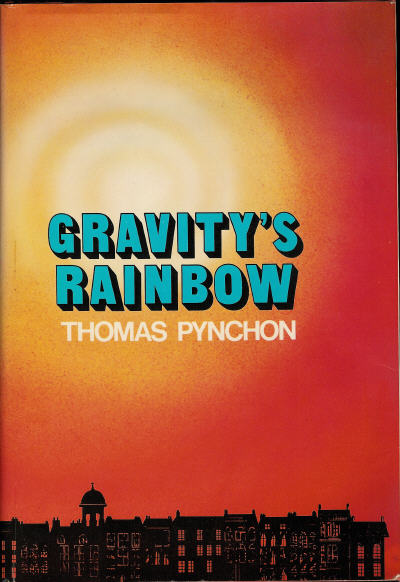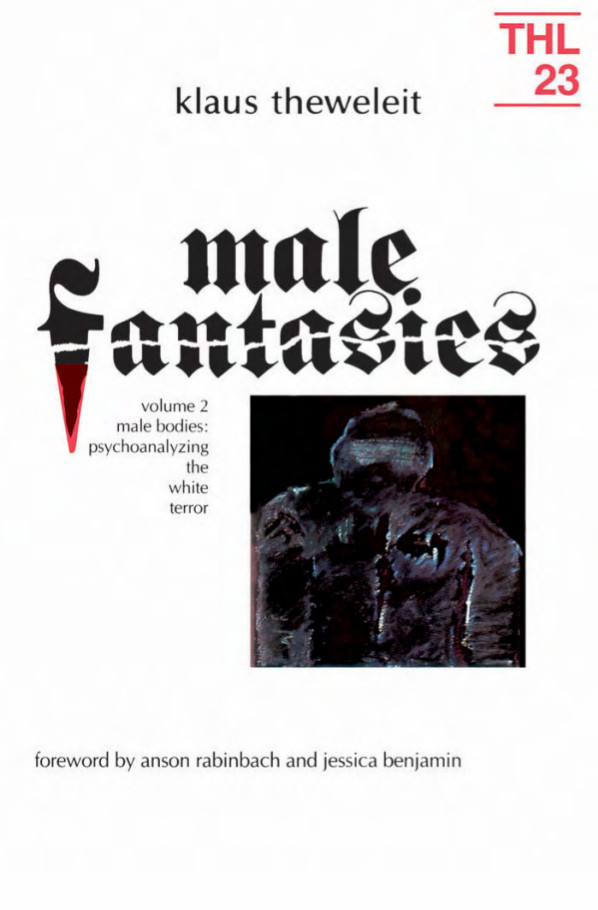Thomas Pynchon: Gravity’s Rainbow (1973-) [EN, IT, HU]
Filed under fiction | Tags: · colonialism, conspiracy, entropy, military, sex, synchronicity, war

A few months after the Germans’ secret V-2 rocket bombs begin falling on London, British Intelligence discovers that a map of the city pinpointing the sexual conquests of one Lieutenant Tyrone Slothrop, U.S. Army, corresponds identically to a map showing V-2 impact sites. The implications of this discovery launch Slothrop on a wildly comic extravaganza.
“Gravity’s Rainbow is Pynchon’s most celebrated novel. An intricate and allusive fiction that combines and elaborates on many of the themes of his earlier work, including preterition, paranoia, racism, colonialism, conspiracy, synchronicity, and entropy, the novel has spawned a wealth of commentary and critical material, including reader’s guides, books and scholarly articles, online concordances and discussions, and art works. Its artistic value is often compared to that of James Joyce’s Ulysses. Some scholars have hailed it as the greatest American post-WW2 novel, and it has similarly been described as ‘literally an anthology of postmodernist themes and devices’.” (from Wikipedia)
A Journey Into the Mind of P, documentary on Pynchon (dir. Donatello Dubini & Fosco Dubini, 2002, 88 min)
Gravity’s Rainbow (English, 2000, EPUB)
Gravity’s Rainbow (English, undated, PDF, unpaginated)
L’arcobaleno della gravità (Italian, trans. Giuseppe Natale, 1999, no OCR, 82 MB), (OCR’d, unpaginated)
Súlyszivárvány (Hungarian, trans. János Széky, 2009, unpaginated)
Klaus Theweleit: Male Fantasies, 2 vols. (1977-78/1987)
Filed under book | Tags: · fantasy, fascism, literature, men, military, nazism, psychoanalysis, sex, sociology, women


These two volumes center upon the fantasies that preoccupied a group of men who played a crucial role in the rise of Nazism. Theweleit draws upon the novels, letters, and autobiographies of these proto-fascists and their contemporaries, seeking out and reconstructing their images of women.
“Theweleit’s study of the fascist consciousness in general and the bodily experience of these former soldiers in particular, easily detected in their hatefilled, near-illiterate books, was well received. Theweleit used Wilhelm Reich, Gilles Deleuze and Félix Guattari for his basic theory, but also empirical research, especially of the leading German left-wing historian of Weimar unrest, his friend Erhard Lucas and he was always discussing his findings with his wife, who has professional clinical experience. Theweleit writes in an anti-academic, highly personal style.” (from Wikipedia)
Heavily illustrated with cartoons, advertisements, engravings, and posters of the era.
Volume 1: Women Floods Bodies History
Originally published as Männerphantasien, Bd 1: Frauen, Fluten, Körper, Geschichte, Roter Stern, 1977
Translated by Stephen Conway, in collaboration with Erica Carter and Chris Turner
Foreword by Barbara Ehrenreich
Publisher University of Minnesota Press, 1987
ISBN 0816614482
517 pages
Volume 2: Male Bodies: Psychoanalyzing the White Terror
Originally published as Männerphantasien, Bd 2: Männerkörper. Zur Psychoanalyse des Weißen Terrors, Roter Stern, 1978
Translated by Erica Carter and Chris Turner, in collaboration with Stephen Conway
Foreword by Anson Rabinbach and Jessica Benjamin
Publisher University of Minnesota Press, 1987
ISBN 0816614504
507 pages
wikipedia (in German)
publisher (Vol. 2)
google books (Vol. 1)
google books (Vol. 2)
Volume 1 (15 MB, updated on 2014-12-7)
Volume 2 (37 MB, updated on 2014-12-7)
Louis Armand, Jane Lewty, Andrew Mitchell (eds.): Pornotopias: Image, Desire, Apocalypse (2008)
Filed under book | Tags: · art, body, gender, image, masochism, pornography, sex, sexuality, theory

Bodily existence is an existence lived in constant fascination with a world beyond one’s reach. Embodiment, desire, metaphor. To exist on the verge of nonexistence. In the headlong pursuit of the real, of the other. Of the base materiality of the world, of religious hypothesis, of absolute relativity. Every utopia is a pornography, a recrudescence and pathological disillusionment, a lure into the vortex–paradoxical annulment of pure reason, compulsion, repetition, consumption.
A fact of bodily existence is to know that the body is our most complex and multi-faceted machine in a world of incessant technological progress. The body is a marvel of engineering; it is the outward face of primal nature; it is a disgusting vessel in which to house the soul; it is a primitive device, fragile and disposable. Bodies are re-produced, experimented upon to the limits of their tolerance, dissected and debated to every last cell, mended, prosthetically enhanced, moralised, abused and adored. The interface with the world we live in means that the body is always laid open to scrutiny without ever simply constituting some thing within our grasp: it is the site where violence and metaphysics interchange, technicity and catatonia, the sublime and the grotesque.
The body cannot be neutral or indifferent. Its design is such that it must respond to both exterior challenge and interior impulse. Our means of survival, the sex act, galvanizes the body into a unique state of existence, which, though transient, becomes the essence of being; the concentration of an idea, the heightening of sense, the ultimate dissolution.
How to write this purposeful transformation? How to write this instantaneous, ephemeral shattering of perception? This is the task of pornography. Our project will present the body in its most extreme of forms and behaviour, all of which demonstrate the human attempt to satisfy, and solve, the oft-inchoate needs of our psychology and physicality. We seek papers which deal with pornography as condition, symptom, addiction, spectacle, product, simulacrum. Above all as a fundamentalism embedded in the very structures of representation, knowledge, non-knowledge and the unpresentable.
Contributors include Georges Bataille, Johannes Birringer, Karmen MacKendrick, Benjamin H. Bratton, Lara Portela, Louis Armand, Stewart Home, Jane Lewty, Thierry Tillier, Ruark Lewis, Malwina Zaremba, Darren Tofts, Bonita Rhoads, Stuart Kendall, Ian Haig, Jena Jolissaint, Pierre Daguin, Vadim Erent, Florian Cramer, Beth Lazroe, Andar Nunes.
Publisher Faculty of Philosophy of the Charles University, Prague, December 2008
Litteraria Pragensia Books series
ISBN 9708073082918
272 pages
PDF (69 MB, updated on 2013-5-11)
Comments (4)
